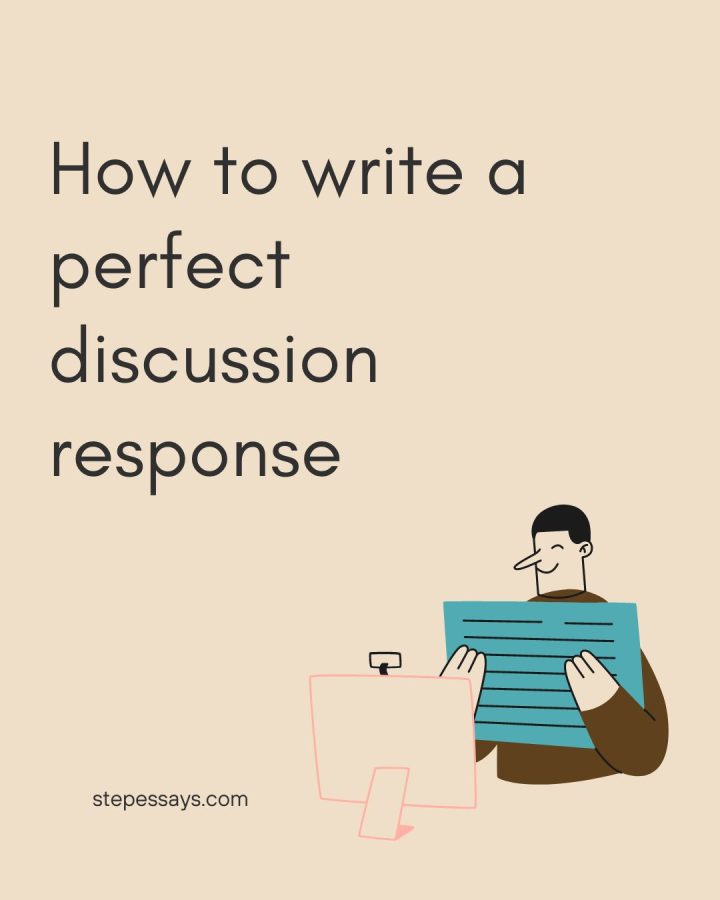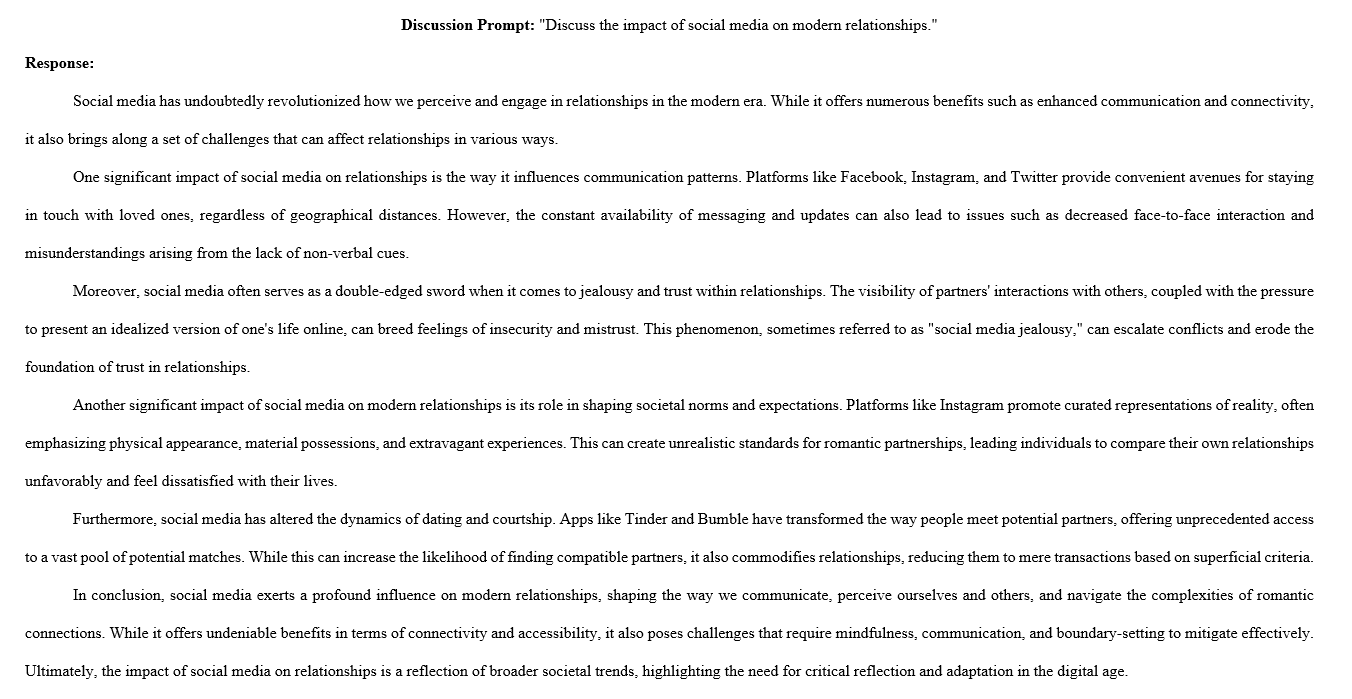Table of Contents
ToggleIntroduction:
In academic and professional settings, discussions are pivotal for sharing ideas, engaging with peers, and fostering critical thinking. Whether it’s in a classroom, online forum, or workplace environment, the ability to craft effective discussion responses is a valuable skill. A perfect discussion response not only showcases your understanding of the topic but also stimulates further dialogue and collaboration. This comprehensive guide aims to equip you with the tools and techniques to write impeccable discussion responses that captivate your audience and contribute meaningfully to the discourse.

Discussion
Understanding the Purpose of a discussion response:
Before looking into the complexity of writing the perfect response, it’s essential to understand the purpose behind such interactions. It responses serve multiple functions:
Demonstrating Comprehension:
Demonstrating comprehension is not basically about showcasing one’s ability to regurgitate information, but rather it serves as a fundamental function rooted in understanding the purpose of crafting a perfect discussion response. It involves the adept application of critical thinking skills to understand the steps of the topic at hand, discerning key concepts, and synthesizing them into coherent arguments or insights.
By understanding the purpose of the response, whether it be to engage in academic discourse, foster collaboration, or contribute to a collective understanding, individuals can tailor their responses to effectively convey their understand of the subject matter. Through thoughtful analysis, interpretation, and articulation, they demonstrate not only their comprehension of the material but also their capacity to engage meaningfully with others, thus enriching the dialogue and advancing collective knowledge.
Critical Analysis:
Promoting Dialogue
Promoting dialogue emerges as a central function when one comprehends the purpose behind crafting a perfect discussion response. Understanding that the aim extends beyond individual expression to fostering collaborative exchange and collective learning underscores the significance of promoting dialogue. By actively engaging with peers, offering constructive feedback, and exploring diverse viewpoints, individuals not only contribute to the enrichment of the response but also cultivate an environment conducive to intellectual exploration and growth.
Recognizing the purpose of the discussion response as a means to stimulate conversation, inspire reflection, and deepen understanding empowers individuals to actively participate in dialogue that transcends individual perspectives and leads to the co-creation of knowledge. Thus, promoting dialogue becomes intrinsic to the art of writing impeccable responses, fostering a dynamic exchange of ideas and fostering a vibrant intellectual community.
Building Community:
Recognizing the purpose of the discussion response as a means to connect with peers, establish meaningful relationships, and cultivate a shared sense of purpose empowers individuals to play an active role in shaping the community’s identity and fostering a culture of inclusivity. Thus, building community becomes intrinsic to the art of writing impeccable responses, fostering a sense of camaraderie and collective ownership over the shared intellectual journey.
Preparation and Engagement of a discussion response:
Thoroughly Review the given rise or Topic:
Thoroughly reviewing the given rise or topic is an essential step in both preparation and engagement when crafting a discussion response. Before delving into writing, take the time to carefully analyze the topic provided. Identify key concepts, questions, or themes that need to be addressed in your response. Consider the scope of the discussion and any specific instructions or guidelines provided.
Research and Reflect:
Engaging in research and reflection is a fundamental aspect of both preparation and engagement when crafting a discussion response. Research allows you to deepen your understanding of the topic by exploring relevant literature, studies, and perspectives. Take the time to gather information from credible sources, critically evaluate their credibility and relevance, and synthesize key findings to inform your response.
Concurrently, reflection enables you to connect the topic to your own experiences, insights, and prior knowledge. Consider how the topic relates to real-world examples, personal anecdotes, or academic concepts you’ve encountered. By engaging in both research and reflection, you can enrich your discussion response with evidence-based insights, critical analysis, and nuanced perspectives, contributing to a more robust and compelling dialogue.
Engage Actively:
Additionally, active engagement fosters a sense of community and collaboration, laying the groundwork for a dynamic and enriching exchange of ideas. By embracing active participation as part of your preparation, you prime yourself to craft a discussion response that is informed, insightful, and responsive to the evolving discourse.
Structuring Your Response:

Response
Introduction:
Introducing your response effectively is paramount when structuring your discussion contribution. The introduction serves as the gateway to your argument, setting the tone and providing a roadmap for what follows. It should succinctly encapsulate the essence of your response while grabbing the reader’s attention. A well-crafted introduction not only outlines the main points you will address but also establishes the relevance and significance of the topic at hand.
Body
Conclusion
Additionally, it may invite further reflection or propose avenues for future exploration, ensuring that the dialogue continues beyond the confines of your response. By leaving the reader with a sense of closure and anticipation, the conclusion enhances the overall impact of your contribution and underscores its significance within the broader discourse. Thus, mastering the art of the conclusion is essential for effectively structuring your response and leaving a lasting impression on your audience.
People Also Read
How to craft a Perfect introduction for your Discussion Response
Mastering the Art of Crafting a Perfect Online Discussion Response
How to write a perfect conclusion for your Discussion Response
Crafting Engaging Content of a discussion response:
Be Concise yet Comprehensive:
Crafting engaging content for a discussion response requires striking a balance between being concise yet comprehensive. While it’s important to convey your ideas clearly and succinctly, it’s equally crucial to ensure that your response covers all necessary aspects of the topic comprehensively. Aim to present your arguments, evidence, and insights in a clear and organized manner, avoiding unnecessary verbosity or tangents. Each sentence should contribute meaningfully to the overall coherence and depth of your response.
By being concise, you respect the time and attention of your audience, keeping them engaged with your ideas. However, being comprehensive ensures that your response is thorough and addresses the complexity of the topic adequately. Therefore, strive to achieve a harmonious blend of conciseness and comprehensiveness in your discussion response, capturing the essence of your argument while providing a robust foundation for further exploration and dialogue.
Use Evidence and Examples:
In crafting engaging content for a discussion response, the use of evidence and examples plays a pivotal role in bolstering arguments and captivating the audience. Providing concrete evidence from credible sources lends authority to your assertions and enhances the persuasiveness of your response. Whether citing academic research, statistical data, or real-world examples, evidence adds depth and validity to your analysis.
Furthermore, incorporating relevant examples helps to illustrate abstract concepts, making complex ideas more accessible and relatable to readers. By grounding your arguments in evidence and examples, you not only strengthen the credibility of your response but also enrich the discussion by offering concrete insights and contextualizing theoretical frameworks within practical contexts. Therefore, leveraging evidence and examples effectively enhances the overall quality and impact of your discussion response, fostering deeper engagement and stimulating meaningful dialogue among participants.
Critical Thinking:
Critical thinking is indispensable when crafting engaging content for a discussion response. It involves the careful analysis, evaluation, and interpretation of information to form well-reasoned arguments and insights. Embracing critical thinking allows you to look beyond surface-level understanding, questioning assumptions, and scrutinizing evidence to uncover underlying complexities and steps within the topic. By engaging in critical thinking, you can identify strengths and weaknesses in arguments, recognize biases, and discern credible sources from unreliable ones.
Avoid Jargon and Ambiguity:
When crafting engaging content for a discussion response, it’s essential to avoid jargon and ambiguity to ensure clarity and accessibility. Using overly technical language or specialized terminology can alienate readers who may not be familiar with the subject matter. Instead, strive for clear and straightforward communication, opting for plain language that is easily understood by a diverse audience. Additionally, ambiguity can lead to misunderstandings and detract from the persuasiveness of your argument.
Be precise in your wording, avoiding vague or ambiguous statements that may leave room for interpretation. By prioritizing clarity and simplicity in your language, you make your ideas more accessible and compelling to readers, fostering greater engagement and understanding within the discussion. Thus, by steering clear of jargon and ambiguity, you enhance the effectiveness of your discussion response, ensuring that your message resonates with your audience and contributes meaningfully to the dialogue.
Respectful Engagement:
Respectful engagement is paramount when crafting engaging content for a discussion response. It involves approaching the conversation with empathy, open-mindedness, and a genuine willingness to consider diverse viewpoints. Respectful engagement entails listening actively to the perspectives of others, acknowledging their contributions, and refraining from dismissive or derogatory language. Furthermore, it involves fostering a culture of mutual respect and inclusivity, where all participants feel valued and empowered to share their ideas without fear of judgment or reprisal. By cultivating an environment of respect in your discussion response, you not only promote constructive dialogue but also create a sense of camaraderie and collaboration among participants. Ultimately, respectful engagement enriches the discourse by encouraging meaningful exchange, fostering empathy and understanding, and cultivating a community where diverse voices are celebrated and honored. Therefore, by prioritizing respectful engagement in your discussion response, you contribute to a more enriching and inclusive dialogue that inspires learning, growth, and mutual respect among peers.
Editing and Polishing:
Proofread for Clarity and Coherence:
Editing and polishing your discussion response is essential for ensuring clarity and coherence in your writing. One crucial step in this process is to thoroughly proofread your response. By carefully reviewing your work, you can identify and correct any grammatical errors, typos, or awkward phrasing that may detract from the clarity of your message. Pay close attention to the flow of your ideas and the organization of your paragraphs, ensuring that each point transitions smoothly into the next. Additionally, consider the overall coherence of your response, making sure that your arguments are logically structured and supported by evidence. By taking the time to proofread your discussion response, you can refine your writing and enhance its effectiveness, ultimately providing a polished and compelling contribution to the discussion.
Check Formatting and Citations:
In the process of editing and polishing your discussion response, checking formatting and citations is paramount. Adhering to specified formatting guidelines ensures that your response maintains a professional appearance and meets any requirements set forth by the context of the discussion. Whether it’s adhering to a particular citation style such as APA, MLA, or Chicago, or following guidelines for font size, spacing, and margins, consistency and accuracy are key. Additionally, verifying citations ensures that you give proper credit to sources and lend credibility to your arguments. By double-checking formatting and citations, you not only demonstrate attention to detail but also uphold academic integrity and contribute to the overall professionalism of your discussion response.
Seek Feedback:

seek feedback
Seeking feedback is an invaluable step in the editing and polishing process of your discussion response. By soliciting input from peers, instructors, or colleagues, you gain fresh perspectives and insights that can help identify areas for improvement. Whether it’s clarity of argument, coherence of structure, or adherence to the discussion give rise, feedback provides invaluable guidance for refining your response. Embrace constructive criticism with an open mind, recognizing that it is instrumental in improving your writing skills and enhancing the quality of your contribution. Moreover, engaging in dialogue with others fosters collaboration and enriches the learning experience for all involved. Ultimately, seeking feedback allows you to iterate and refine your discussion response, ensuring that it is polished, compelling, and impactful.
Conclusion:
Mastering the art of writing perfect discussion responses requires a combination of preparation, engagement, critical thinking, and effective communication skills. By following the strategies outlined in this guide, you can elevate your discussion responses from basic contributions to meaningful contributions that inspire dialogue, foster collaboration, and leave a lasting impression on your audience. Remember, the goal is not just to participate in the discussion but to actively contribute to the advancement of knowledge and understanding in your field. Remember, the goal is not just to participate in the discussion but to actively contribute to the advancement of knowledge and understanding in your field. In conclusion, writing a perfect discussion response requires a combination of preparation, engagement, critical thinking, and effective communication skills. By following the strategies outlined in this guide and incorporating additional tips for enhancing your responses, you can elevate your contributions to discussions and make a meaningful impact in your academic or professional endeavors. Remember, the goal is not just to communicate your ideas but to foster dialogue, collaboration, and collective learning within the community. Here are some additional tips to enhance your discussion responses:
Tips to enhance your discussion responses
Be Mindful of Tone:
Being mindful of tone is a crucial tip to enhance your discussion response. The tone you employ sets the atmosphere for the entire exchange, influencing how your message is perceived by others. Aim for a tone that is professional, respectful, and inclusive, fostering a positive and constructive dialogue. Avoid language that is overly aggressive, confrontational, or dismissive, as this can hinder communication and create unnecessary tension.
Instead, strive for a tone that is diplomatic and empathetic, acknowledging differing viewpoints while articulating your own perspective thoughtfully. By being mindful of your tone, you can ensure that your discussion response resonates with your audience, encourages meaningful engagement, and contributes to a collaborative and supportive discourse environment.
Acknowledge and Build Upon Others’ Contributions:
Stay Relevant:
Keep your response focused on the topic at hand. While tangential discussions may arise naturally in a conversation, make sure your contributions remain relevant to the main discussion thread. Avoid going off on unrelated tangents, as it can distract from the core issues being discussed.
Use Active Listening Skills:
Effective communication is not just about speaking; it also involves active listening. Pay attention to what others are saying in the discussion and respond thoughtfully to their points. Acknowledge their contributions, ask clarifying questions if needed, and demonstrate empathy towards different viewpoints.
Embrace Constructive Criticism:
Be open to receiving feedback on your discussion responses. Constructive criticism can help you identify areas for improvement and refine your writing style. Take feedback graciously, and use it as an opportunity for growth and self-improvement.
Practice Empathy and Inclusivity:
Foster a welcoming and inclusive environment in the discussion by practicing empathy towards others’ perspectives and experiences. Be mindful of the diverse backgrounds and viewpoints represented in the discussion, and strive to create a space where everyone feels heard and valued.
Continuous Learning:
Treat every discussion as an opportunity for learning and growth. Stay curious, ask questions, and seek to expand your knowledge base with each interaction. Engage with the material critically, and be open to revising your opinions in light of new information or insights gained from the discussion.
Frequently Asked Questions
How to reference a discussion post response
How to Write a Discussion Response Questions
How to write a discussion short response paper
An Example of Discussion Response

